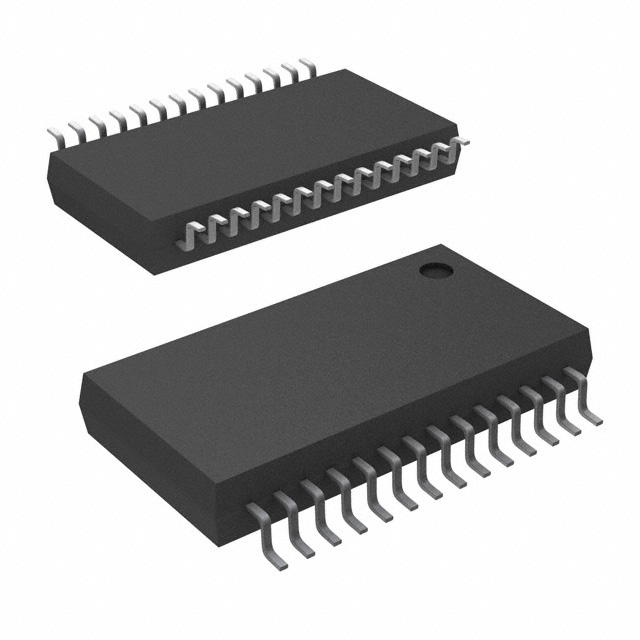DAC8820IBDB
Product Overview
Category: Digital-to-Analog Converter (DAC)
Use: The DAC8820IBDB is a high-performance, precision digital-to-analog converter designed for various applications that require accurate conversion of digital signals to analog voltages. It is commonly used in audio systems, industrial control systems, instrumentation, and communication equipment.
Characteristics: - High resolution: The DAC8820IBDB offers a resolution of up to 16 bits, ensuring precise conversion of digital data. - Low power consumption: It operates at low power levels, making it suitable for battery-powered devices. - Fast settling time: The converter provides fast settling time, enabling quick response in dynamic applications. - Wide voltage range: It supports a wide voltage range, allowing compatibility with different power supply levels. - Low distortion: The DAC8820IBDB ensures low distortion and noise, resulting in high-quality analog output signals.
Package: The DAC8820IBDB is available in a small form factor package, such as a 24-pin SSOP (Shrink Small Outline Package), which facilitates easy integration into compact designs.
Essence: The essence of the DAC8820IBDB lies in its ability to accurately convert digital signals into corresponding analog voltages, providing a crucial interface between digital and analog domains.
Packaging/Quantity: The DAC8820IBDB is typically sold in reels or tubes containing multiple units, with each reel/tube containing a specific quantity of converters.
Specifications
- Resolution: Up to 16 bits
- Supply Voltage Range: 2.7V to 5.5V
- Output Voltage Range: 0V to Vref
- Operating Temperature Range: -40°C to +105°C
- Total Unadjusted Error: ±1 LSB (maximum)
- Settling Time: 10µs (typical)
- Power Consumption: 0.5mW (typical)
Detailed Pin Configuration
The DAC8820IBDB features a 24-pin SSOP package with the following pin configuration:
- VDD - Power supply voltage
- VREF - Reference voltage input
- AGND - Analog ground
- OUTA - Analog output A
- OUTB - Analog output B
- GND - Ground
- DIN - Serial data input
- SCLK - Serial clock input
- SYNC - Chip select input
- LDAC - Load DAC input
- CLR - Clear input
- REFOUT - Reference voltage output
- VLOGIC - Logic supply voltage
- DGND - Digital ground
- D7 - Data bit 7
- D6 - Data bit 6
- D5 - Data bit 5
- D4 - Data bit 4
- D3 - Data bit 3
- D2 - Data bit 2
- D1 - Data bit 1
- D0 - Data bit 0
- NC - No connection
- NC - No connection
Functional Features
- High-resolution digital-to-analog conversion
- Low power consumption for energy-efficient operation
- Fast settling time for dynamic applications
- Wide voltage range compatibility
- Low distortion and noise for high-quality analog output
Advantages and Disadvantages
Advantages: - High resolution ensures accurate conversion - Low power consumption extends battery life - Fast settling time enables quick response - Wide voltage range compatibility enhances versatility - Low distortion and noise result in high-quality output
Disadvantages: - Limited pin configuration options due to package size - May require external components for specific applications
Working Principles
The DAC8820IBDB operates based on the principle of converting digital input data into corresponding analog voltages. It utilizes an internal digital-to-analog conversion technique, where the digital input is processed and transformed into a precise analog output signal. The converter's internal circuitry ensures accurate conversion with minimal distortion and noise.
Detailed Application Field Plans
The DAC8820IBDB finds applications in various fields, including:
- Audio Systems: Used for high-fidelity audio reproduction in amplifiers, mixers, and digital audio equipment.
- Industrial Control Systems: Enables precise control of industrial processes by converting digital control signals to analog outputs.
- Instrumentation: Provides accurate analog voltage generation for measurement and testing equipment.
- Communication Equipment: Used in communication systems for signal modulation and demodulation purposes.
Detailed and Complete Alternative Models
- DAC8821IBDB: Similar to DAC8820IBDB but with enhanced features.
- DAC8822IBDB: Dual-channel version of DAC8820IBDB for stereo applications.
- DAC8824IBDB: Quad-channel variant offering simultaneous conversion of multiple channels.
- DAC883
Lista 10 Vanliga frågor och svar relaterade till tillämpningen av DAC8820IBDB i tekniska lösningar
Sure! Here are 10 common questions and answers related to the application of DAC8820IBDB in technical solutions:
Q: What is DAC8820IBDB? A: DAC8820IBDB is a digital-to-analog converter (DAC) integrated circuit that converts digital signals into analog voltage outputs.
Q: What is the operating voltage range of DAC8820IBDB? A: The operating voltage range of DAC8820IBDB is typically between 2.7V and 5.5V.
Q: How many channels does DAC8820IBDB have? A: DAC8820IBDB has two independent channels, allowing for simultaneous conversion of two different digital inputs.
Q: What is the resolution of DAC8820IBDB? A: DAC8820IBDB has a resolution of 16 bits, providing high precision in converting digital signals to analog voltages.
Q: Can DAC8820IBDB be used in industrial applications? A: Yes, DAC8820IBDB is suitable for various industrial applications such as process control, automation, and instrumentation.
Q: Does DAC8820IBDB require external components for operation? A: Yes, DAC8820IBDB requires external reference voltage and decoupling capacitors for proper operation.
Q: What is the output voltage range of DAC8820IBDB? A: The output voltage range of DAC8820IBDB is determined by the reference voltage provided externally.
Q: Can DAC8820IBDB operate in both unipolar and bipolar modes? A: Yes, DAC8820IBDB can be configured to operate in either unipolar mode (0V to Vref) or bipolar mode (-Vref/2 to +Vref/2).
Q: What is the maximum output current of DAC8820IBDB? A: The maximum output current of DAC8820IBDB is typically 5mA per channel.
Q: Is DAC8820IBDB compatible with microcontrollers and digital signal processors (DSPs)? A: Yes, DAC8820IBDB can be easily interfaced with microcontrollers and DSPs using standard serial communication protocols such as SPI or I2C.
Please note that these answers are general and may vary depending on specific application requirements and datasheet specifications.


